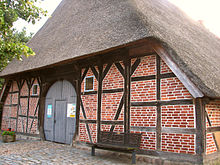Priesthood
The priesthood is a former pastorate in the Büchen district of Büchen-Dorf. Together with the St. Mary's Church opposite, it forms a sight of the Duchy of Lauenburg .
The building is considered to be the oldest listed building in the district that was formerly used for agriculture. As a two-column construction with a thatched roof and clay filling, it belongs to the type of a Lower Saxony specialist hall house .
history
According to tradition, in 1634 (during the Thirty Years' War ) the Pötrau pastor Pistonus shot an imperial soldier who wanted to pillage the Pötrau pastorate. Thereupon - according to tradition - the imperial soldiers took revenge by destroying the pastorates in Pötrau and Büchen and seriously damaging the churches.
In 1649, the year following the end of the Thirty Years' War, the priesthood was built as a new pastorate and a sign of a new beginning. It served the Büchen pastor as an official residence and residence and for agricultural purposes. The stalls of the Union of Knights and Landscapes of the Duchy of Saxony-Lauenburg, founded in 1585, met there . These had met before the completion of the priesthood in the Marienkirche.
The priesthood was sold by the church to the community of Büchen in 1987 and has been a listed building since then due to its historical and structural importance. The restoration was completed in 1991 and the priesthood was inaugurated on August 30, 1991 as a cultural site of the Duchy of Lauenburg. During this time, the originally popular name Priesterkate became an official name for the building.
Usage today
Today the priesthood is open to the public as a cultural meeting point and presents a permanent exhibition on the history of the community. The focus of this exhibition is the history of Büchen as a border town from the time of Charlemagne to the Cold War .
In addition, various events and other exhibitions take place in the priesthood.
The building is also used for weddings by the Büchen registry office.
literature
- Hermann Augustin , Martin Sommerfeld: witnesses to religious and cultural history. Field stone churches in the Lauenburger Land .
- Andreas Rumler: Schleswig-Holstein. Culture, history and landscape between the North Sea and the Baltic Sea, the Elbe and the Flensburg Fjord.
Web links
Coordinates: 53 ° 28 ′ 49.4 " N , 10 ° 38 ′ 16.4" E
